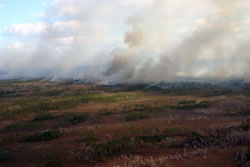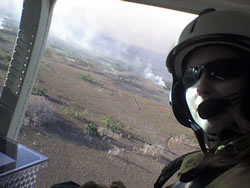
National Fire Plan Success Story
Park Completes Third Year of Restoration Project
Big Cypress National Preserve, Florida
National Fire Plan - Fuels Reduction
2009

An example of a landscape-scale prescribed burn ignited using aerial ignition at Big Cypress National Preserve.

Lead Fire Effects Monitor Mindy Wright operates a plastic sphere dispenser to conduct aerial ignition during a prescribed burn at Big Cypress National Preserve.
In 2009, Florida’s Big Cypress National Preserve continued on course to restoring the historic fire return interval to a half-million acres of fire-dependent landscape.
Historically, the Big Cypress landscape burned every 3 or 4 years. Burnable vegetation on the 3/4-million acre Preserve spans over 450,000 acres, not counting the cypress strands and domes, which also may burn on a less frequent interval. In 2007, approximately 100,000 acres burned including the Big Cypress Complex wildfire. In 2008, Big Cypress Fire Management Officer John Nobles and his staff completed their goal of 70,000 acres, with the intent of completing all 450,000 acres in 5 years. In 2009, the Preserve took one step closer to that goal, burning another 70,000 acres under prescription.
The lightning-ignited Deep Fire started on April 22, 2009, and burned across Interstate 75. The areas both north and south of I-75 were slated for prescribed fire treatment. As part of this planned treatment, park staff had cleared brush and burned out vegetation around six private camps and residences, as well as other burn units on the north side of the lightning strike. These previous treatments significantly reduced the cost of containing the Deep Fire.
The vision is unique in its scope and even more ambitious in its implementation. Outside of Alaska and post-1988 Yellowstone, nowhere else in the United States has fire been restored to the ecosystem on such a large scale. Other Federal areas, such as Apalachicola National Forest, conduct large-scale prescribed fire, but their landscapes have been significantly altered already by cultivation and mechanical fuel reduction. At Big Cypress, fire is being restored to an ecosystem that has witnessed few historical human disturbances. Big Cypress leads the National Park Service in annual acres treated with prescribed fire.
Wildland/urban interface has added to the complexity at Big Cypress. Interspersed throughout the Preserve are 550 inholder camps containing approximately 3,000 structures. Firefighters took actions to protect these camps as well as campgrounds, bird nesting and panther denning areas, monitoring stations and three highly-traveled road corridors.
Contact: George Sheppard, Assistant Fire Management Officer, (239) 695-9280 x 103.